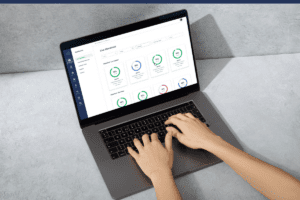How Career Colleges Can Track Attendance Across Different Learning Environments
How trade and technical schools can track timely and accurate student attendance in distance learning, onground learning, and externships.
The scene is iconic for a reason. Anyone who has sat through a roll call knows it’s a dull, time-consuming way to begin class. For trade and vocational schools, however, taking attendance is no joke—funding and compliance depend on it.
Attendance data, traditionally collected on paper or with a biometric scanner, is directly tied to career college funding and accreditation. Traditional attendance methods already present problems inside the classroom like long lines and manual data entry, but they are simply obsolete with the emergence of online and blended learning.
Fortunately, new technology collects attendance in every career college learning environment—onground learning, distance learning, externships—and automatically consolidates real-time data into one actionable student dashboard.
Here are the best attendance solutions for every learning enviornment.
Attendance technology for on-site learning: Soundwave
Soundwave technology is the best attendance solution for on-ground, in-person learning because it ensures that students earning time are within the four walls of the classroom. When it’s time to check in, instructors issue a silent tone from their phone or tablet that is picked up by students’ devices and checks them into class. Even if a student is right outside the door, their phone will not pick up the sound, making it impossible for a student to buddy punch or rig the system.
Attendance technology for externships: GPS
It’s no secret; tracking externship data is extremely challenging. Traditionally, administrators collect self-reported attendance sheets from students and then verify the attendance data accuracy with phone calls to site preceptors. Site preceptors must sort through their paper records, sometimes weeks later, to confirm whether the student data is accurate. If a student’s data is inaccurate and they’ve unknowingly fallen behind on their externship hours, they are dropped from the program, no questions asked, and have to restart from scratch.
Using a GPS attendance system, externship coordinators can place a geofence an entire externship site or a single room, depending on the program requirements. Students can only check in once they are in the precise externship location. For an extra layer of security, administrators can combine GPS and QR code check-in by placing QR codes around the building.
Using GPS, externship coordinators receive real-time attendance data and can use it to intervene with at-risk students early. Plus, ending the game of phone tag with site preceptors helps maintain a positive relationship with externship sites.
Attendance technology for synchronous online learning: QR Codes
Although COVID-19 initially prompted the shift to online learning, many career colleges and vocational schools plan to continue blended learning programs for the foreseeable future. The best attendance option for continued online courses is a unique QR code. Instructors simply place a QR code at the bottom of each slide, and if a student is late, they can still check in without disrupting class.
Placing the burden on instructors to manually monitor attendance during synchronous courses pulls their attention away from creating an engaging lesson for their students, which is already hard enough in an online setting. Plus, without a digital solution, instructors still have to send attendance data to administrators for manual entry into the SIS. A QR code allows instructors to focus on students while giving administrators the information they need in real-time.
Attendance technology for asynchronous online learning: Face/Fingerprint ID
During asynchronous online learning activities, administrators must prove that the registered student is the person completing the assigned work. Instructors can verify a student’s identity using Face or Touch ID before each asynchronous assignment. Students are unable to access the assignment without first scanning their faces or fingerprints, a technology so secure that many banking apps also use it to verify customer identity. Administrators have peace of mind knowing that their data is verifiable during an audit.
Why career colleges should choose a digital attendance solution
A digital attendance solution like CourseKey gives schools the flexibility to securely track attendance across multiple environments and empowers administrators by consolidating real-time attendance data into one clear dashboard. Equipped with attendance dashboards, administrators can check every student’s academic progress and proactively intervene before an at-risk student misses too much time, ensuring student success.
CourseKey takes this one step further by automating intervention when students are at-risk. Once students hit a certain risk threshold, for example too many absences in a row, CourseKey will automatically notify that student that they’re at risk. CourseKey will also notify the appropriate administrator so they can spend more time taking action to support at-risk students and less time managing data.
If you’d like to learn more about how CourseKey helps schools better track attendance across all learning environments, request a demo.
Recent Articles

















